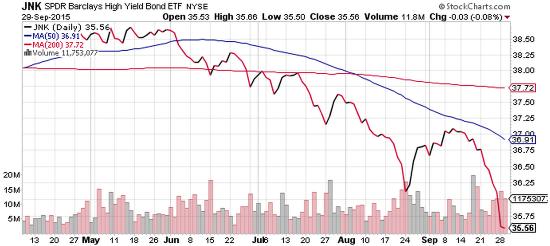One of the early signs that a cycle is about to turn down is disorder in junk bonds. That’s because the companies that issue such bonds are by definition financially and/or operationally weak and therefore ultra-sensitive to changes in their environment. A modest drop in, say, consumer spending or the price of wind turbines will hardly be noticed by an Apple (NASDAQ:AAPL) or General Electric (NYSE:GE) but might threaten the survival of those companies’ weakest competitors. And as credit bubbles inflate, the weak in every field tend to proliferate as overexcited bankers and bond funds offer them plenty of rope with which to hang themselves.
So when such bonds start falling — which is to say when their yields start rising — that’s a sign of broad-based trouble ahead. From Tuesday’s Wall Street Journal:
Today’s Big Number: 15.7% of high-yield bonds trading at distressed levels
The commodity -price crunch fueled by China’s economic slow-down is taking a toll on the bond market.
Bonds from debt-laden companies in the metals, mining and steel industries are driving up distress ratios, an indicator that a wave of debt defaults could be on the horizon.
As of mid-September, nearly 15.7% of the roughly 1,720 bonds rated below investment grade traded at distressed levels, the biggest share since 2011, according to Standard & Poor’s Ratings Services. Such bonds were trading with yields at least 10 percentage points over comparable U.S. Treasurys. Yields on bonds rise when prices fall.
Companies with distressed bonds may not be able to refinance or access other forms of capita, said Diane Vazza, an S&P managing director.
The numbers suggest that many companies could default in the next seven to nine months. “There’s a very strong correlation” between bonds that fall into the distressed category and defaults, she said.
It’s not surprising that the commodities crash would impact the bonds of coal and oil companies. The big question is whether the carnage spreads to other kinds of junk. And over the last couple of months it has. The chart below shows the price of SPDR Barclays (LONDON:BARC) High Yield Bond Fund (NYSE:JNK), a junk bond ETF that last week plunged through the lows of the August mini-panic.
Wolf Richter and Zero Hedge just posted long, insightful pieces on this subject. See, respectively, This is When Bonds Go Kaboom! and BofA issues dramatic junk bond meltdown warning.
The short version of the story is that if things play out as they have in past down-cycles, junk defaults will spike from here and capital will flow out of this and other volatile markets and into the safest havens, which historically have been high-grade government bonds, the shares of rock-solid, non-cyclical companies, and, frequently, precious metals.
Governments, meanwhile, will respond with lower interest rates, big deficits and tax cuts. Which is where our story departs from the standard script: With money already extremely easy in most places and sovereign debt at record levels, the government response will have to be either non-traditional or numerically extreme. That is, negative interest rates and helicopter money.
So today’s junk implosion differs from those of 1990, 2000 and 2007 not in itself but in the changes it might set off in the broader economy.

